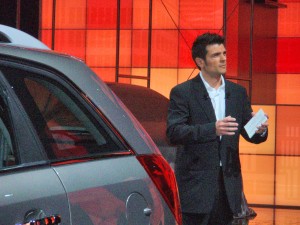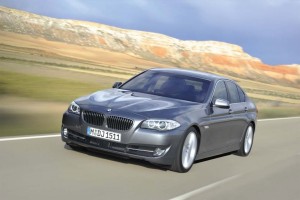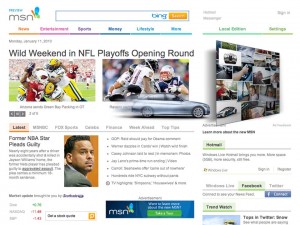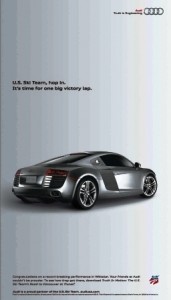BMW launches new campaign based on the “joy” of driving
BMW’s slogan “The Ultimate Driving Machine” has been part of the brand’s DNA since 1974, according to Dave Kiley’s book Driven, when the Ammirati &Purvis ad agency pitched it to the BMW execs in Munich (including Bob Lutz) in their new business presentation that won them the account.
A phone call from a public relations person alerted me to a hot release headed my way about the new BMW campaign, “the joy of driving,” from the brand’s worldwide agency GSD&M. Joy, but considering the long history of “Ultimate Driving Machine,” perhaps shocking is an equally applicable term.
In a subsequent phone interview with Jack Pitney, vice president marketing of BMW, prompted my first question “Are you giving up the Ultimate Driving Machine slogan?” Pitney, who was home sick in bed answered rather hoarsely “We are not giving up the best, longest running automotive slogan ever written: The Ultimate Driving Machine. Our research showed the time was right to move to softer, more personally involving advertising communications.”
That’s how our conversation began about the new ad campaign. Here a few excerpts from that conversation.
TheDetroitBureau: Why the switch from intensive product and technology advertising to a brand image campaign?
Jack Pitney: This campaign was born more than a year ago based on the belief that in the worldwide economic recession, the brands that win in that environment are those who are authentic, purpose-based brands who are true to who they are and what they are over long periods of time. If ever there was a time to remind people about what BMW stands for … now is that time.
TDB: But that’s BMW’s product and technology-driven communications, isn’t it?
Pitney: The classic BMW approach would have been to focus on the products themselves but a lot of our research says people respect, admire and are passionate about the BMW brand. But a lot of folks feel it’s too cool and aloof, which could not be further from the truth. We needed to tap into that passion as opposed to focusing on the product itself. We should focus on how the products make you feel.
TDB: Isn’t the fun of driving and exclusivity the keys to BMWs continued growth?
Pitney: In the end we’ve always been about building products that are about bringing the joy of driving to life, so we thought, that rings true. People would appreciate a more hopeful, optimistic message especially in this economic environment which absolutely rings true to the BMW brand. That was the thinking behind the campaign: to focus on how the product makes you feel. Because, in the end, that’s why people buy BMWs.
TDB: How does “joy” generate customers for the brand?
Pitney: BMW is not a mass market brand, we don’t appeal to everybody, but within our market we felt that focusing on that joy of driving, celebrating how our products make you feel would be an interesting way to get into the emotion behind the product
TDB: Why launch it now?
Pitney: The campaign had been introduced last year in Germany, France and the UK, but we needed the right media platform to launch the new Joy of Driving campaign here in the U.S. We wanted to launch it in a big bang way and thought “Wow the Olympics!” There’s not an advertising platform that is as joyful and triumphant as the Olympics.
TDB: What has been the reaction in Europe and within BMW in the US?
Pitney: It is not only ringing true with the BMW faithful, it is changing peoples’ perceptions about the brand making it more human, approachable. Our dealers and employees are ecstatic about the campaign. It is an emotional approach and we are a brand of profound emotion.
TDB: What are the media splits?
Pitney: The campaign is predominantly television – 78.6%, digital with 12.9%, print at 5.1% and out-of-home at 3.4%. The campaign was created by GSD&M Idea City with Universal McCann handling the media buys.
Here are some critical elements of the new joy campaign.
First use of joy I could find was last year, maybe as a research teaser, in this commercial.
One of the BMW commercials which appeared on the Olympic broadcast.
Last month BMW mounted a home page takeover of MSN with 3D-video that linked to another site for ‘Golden Moments of Joy” at NBCOlympics.com
The current issue of Vanity Fair’s “Hollywood” issue features this four page ad
spectacular:
Olympic Games auto-mercials recap
While the Olympic games gave out prestigious gold, silver and bronze medals for amazing athletic feats, this update will use steel, tin and lead medals for the various commercials I happened to see on NBC’s coverage of the 82nd Olympic Games.
There were some very well done automotive spots created for the Games – especially embattled Toyota’s funsational Sienna commercial, paired wth the maker’s Mia Culpa spot; the launch of BMW’s new “Joy” campaign; and Audi deserves praise for their ski team sponsorship which resulted in this post-Olympics full page ad.
Everyone who watched the Games had their favorites for the automotive and other categories. But … this is not about the good, this is about the bad.
There were other important activities for my entertainment pleasure beyond just sitting transfixed through interminable hours of endless broadcaster babble, excitement-interruptus, Carrillo’s endless Canadiana tours and enough inside-the-sport jock-jargon to induce slumber or somnambulist wanderings.
Among our more dubious honors, we present:
Buick LaCrosse – Steel for great use of skating graphics that didn’t sell the car. Click here.
Chevy, Official Car of the Olympics – lead for the worst outtake reel ever – Click Here.
Nissan Leaf – Lead for the new, not-for-sale-yet electric car. Click Here.
Finally to all advertisers who ran just too many of the same commercial(s) over and over and over and over again, there must be research to show constant repetition has a direct relationship to the loss of effectiveness.
Bloodbath at the Caddy Corral

Another shake-up at GM, this one targetting sluggish Cadillac, including now-ousted General Manager Bryan Nesbitt.
It’s nothing personal of course. It’s about a 34% drop in Caddy sales last year and through February this year, the luxury brand from once Grandiose Motors sales are behind the rest of the stable. Used to be the ad agency took the fall, not this time.
This is the new GM: people are to blame. As a result Grumpy Motors has fired, let-go, terminated, sacked three Caddy marketing execs: Steve Shannon, John Howell and Jay Spenchian. All were members of the team that selected Bogle Hegarty, a couple of months ago, to replace long-time agency Leo Burnett. Their new ads ask an unintended question: why were agencies switched?
Meanwhile, designer-cum-general manager Bryan Nesbitt has been relieved of his Cadillac duties, while Susan Docherty has been stripped of her sales responsibilities — but still retains her marketing duties.
In his first meeting with the news media, a brief webchat, a few months back, GM’s new Chairman and CEO Ed Whitacre Jr. was asked how long he would tolerate a senior manager failing to deliver. “Not long,” he typed, quickly adding a smiley face. Apparently, a frown would have been more appropriate.



